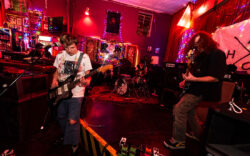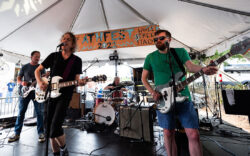It’s been 37 years since Agent Orange was born. The group, led by singer and guitarist Mike Palm and featuring bassist Steve Soto (of Adolescents) and drummer Scott Miller, cut a distinctive swath for itself among the Orange County, CA scene. It was among the first to use surf-rock riffs and arrangements within a punk context, and in the process it reconfigured this musical dialect into an essential soundtrack for the then-burgeoning skate-rock scene.
Palm’s bloodline runs to that sound’s infancy. His cousin, Jim Tran, was the bassist for early-’60s band The Original Surfaris, named such after a dispute with the more economically successful Surfaris (“Wipe Out”), who had released a hit record under the name. The undisputed king of surf guitar, Dick Dale, was from Orange County, too, and Agent Orange shredded out a version of his “Misirlou” a full 13 years before Pulp Fiction resurrected it once again.
Soto left the group soon after it formed, and the late James Levesque took his place. Palm wrote most of the songs for the group’s 1981 debut, Living In Darkness, but Lavesque’s contributions have been called essential by longtime fans. Released on Posh Boy Records, the album opens with what is undoubtedly Agent Orange’s most well-known song, “Bloodstains.”
A staple of any respectable skate-rock collection, the song—made more famous when The Offspring covered it—declares in its lyrics: “Things seem so much different now/ The scene has died away.” For punks, wannabe punks and curious onlookers around the United States, especially those areas that had no punk scene at all, this was a total letdown, like getting told school was dismissed before you even had a chance to enroll. But as with everything worth exploring, context is important.
Orange County is synonymous with wealth. Every stereotype one can conjure with regard to conservative suburbia was likely hatched there first. Plus, it’s absolutely gigantic. Its 3 million residents populate a full 34 proper cities. Area bands of the time, such as Social Distortion, TSOL, The Vandals, Adolescents and D.I., had more than enough targets for their lyrical and musical barbs, leading to what one can imagine was a sense of heavy ennui.
But Agent Orange never sounded much like their peers, especially by 1986, when their second album, This Is the Voice, came out. The original trio was still intact, but the songs had shifted into high-gear, mod-influenced sharpness. “It’s In Your Head” and “I Kill Spies” could’ve been compositions by The Jam (albeit with U.S. accents). The high-energy pop of “Fire in the Rain” was a nod to the nascent college-rock sound that was just starting to twist around the nation. Still, Agent Orange was ensconced solidly with the skate scene, which at that time was more about a feeling of propulsion than any codified sound. (It was around this time that Agent Orange had its own board—designed by Palm and Lavesque—issued by Vision Skateboards.)
The third Agent Orange album, Virtually Indestructible, came out in 1996 and the band spent the next two decades touring the world, including several runs on the Vans Warped Tour. Since 2003, Palm has been joined by bassist Perry Giordano (aka Perry Gx) and drummer Dave Klein from The Bomboras, who were named after a song by The Original Surfaris. So, not exactly full circle, but pretty darn close.
Lineup changes notwithstanding, Agent Orange is unique among bands that have held their name for nearly four decades. Whereas so many groups, punk and otherwise, have been having a real ball of a time of late by reforming and getting high-dollar gigs, Agent Orange simply never stopped playing. Live video from only weeks ago, when the band was in Sydney, Australia, just hit the web, and through the sweat, noise and swirling crowd, one thing is clear: Age only erodes urgency if you allow it.
Like what you just read? Support Flagpole by making a donation today. Every dollar you give helps fund our ongoing mission to provide Athens with quality, independent journalism.









